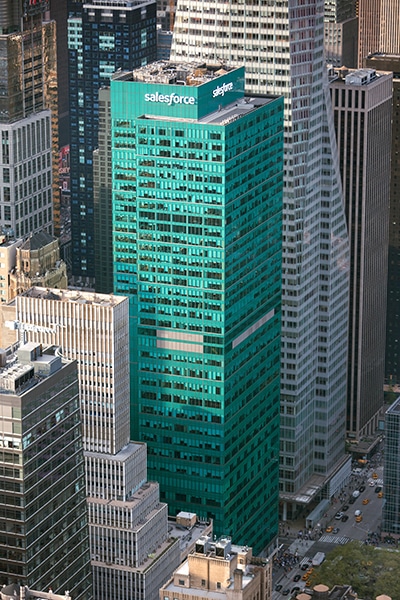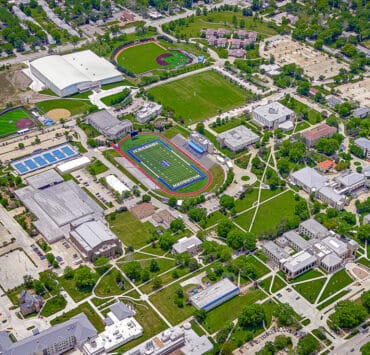|
Getting your Trinity Audio player ready...
|
Salesforce has engaged its sustainability efforts with such gusto that in just six years, its green real estate certification has grown from 30 percent to more than 80 percent today. Amanda von Almen, head of sustainable built environment at Salesforce, says a great deal of that success lies in the culture of the company that is willing to take on such a pressing issue with the timeliness it deserves.

“You cannot accomplish any of this in a vacuum,” she explains. “The real estate team embraced this vision with open arms, and that incredible willingness and excitement around sustainability has made all of this possible.”
Salesforce’s investments aren’t confined in-house. Its ability to engage its entire real estate supply chain in mutual partnership, not dictated terms, is why the company’s green initiatives have the implications of doing exponential good throughout the entire building process. That commitment is what brought the young von Almen to Salesforce in the first place.
A Broader Perspective
It may be that von Almen’s ability to incur wide change stems from how her perspective has always had a broader view. She attended grad school in Scotland at the University of Edinburgh, partly because of the respected sustainability programs and partly to see the world through a less US-centric lens.
She traveled to Kenya to study the conflict between the conservation movement and the development industry. Traditionally, black-and-white issues were grayed when confronted with challenges like a preserve meant to protect rare species cutting off vital water access to residents nearby.
“I learned that you just can’t go in and enact policy,” von Almen explains. “There are so many intertwined social issues that need to be balanced when taking on something this important.”
The sustainability professional’s eventual return to the States also mandated an evolution. Upon moving to Texas for her first sustainability role in the US, von Almen was working within a system that did not see climate change as an issue.
“That’s why when I was looking for my next role, I wanted to work for an organization where our values aligned,” von Almen says. “When that happens, you can accelerate the change and impact that you have within the organization.” Her career growth since being hired as a green building analyst back this up.

Intentional Focus and Shared Values
Since von Almen’s arrival six years ago, the change has been massive at Salesforce, with a leadership team that has stayed almost entirely intact. “We started with reviewing our entire real estate processes and seeing where we could build sustainability into standards and guidance,” she says. “We looked at everything from how, when, and where we site buildings to baking sustainability into the traditional transactions and leasing process.”
Design was also recalibrated. von Almen says that Salesforce’s intentional focus on design lent itself to considering what they want people walking through its doors to think of the company. “As soon as you enter our doors, we want everyone to understand that sustainability is a core value and present throughout all parts of our real estate strategy.”
Instead of opting for one traditional certification process, the Salesforce team picked apart the different high-impact strategies and aligned itself on the priorities where they felt they could make the most lasting change, like energy efficiency and life cycle assessment of building materials. Salesforce made public commitments to ensure accountability from multiple sources and follow-through on the vision.
The Entire Chain
One of von Almen’s proudest accomplishments has been the creation and utilization of a six-part holistic tool the design team uses to evaluate building products and materials. The healthy and sustainable materials scoring tool breaks down a litany of factors that ensure the safest and most environmentally conscious materials are going into Salesforce builds. The score includes high-impact strategies and certifications across health (IAQ, off gassing, chemicals of concern, etc.), carbon (operational and embodied), materiality (recycled content), water, waste, and social responsibility (D&I, community engagement) criteria.
“We started having meaningful supply chain engagement conversations with our real estate suppliers,” von Almen explains. “If you want true sustainability, you can’t just be looking within your own four walls. You have to think about your entire value chain.”

According to von Almen, vendors Brightworks, Herman Miller, Interface, Steelcase, and Stok have been standout partners in creating positive ripple effects through Salesforce’s entire supply chain. “If we can inspire others to join us on this journey and start measuring their own impact, that’s where we can have true impact,” von Almen adds.
The support from Salesforce real estate vendors inspired the company to announce it was adding a Sustainability Exhibit to all supplier procurement contracts, with a goal of reducing the company’s collective carbon footprint. The real estate sustainability efforts have become a testing ground that are later able to be spread throughout the company.
While only a few of Salesforce’s green initiatives are highlighted here, it’s the broad focus across the company that has kept von Almen in-house for the last six years and why she loves her work immensely. “No matter how much you dig in here, you’ll find no ‘greenwashing’ or shaky foundations,” von Almen says. “We’ve built something that’s so solid, we can all be really proud of it.”
Learn more about how Brightworks has helped enable Salesforce’s sustainability efforts.


